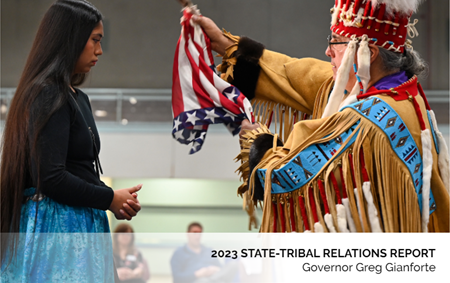About Our Tribal Partnerships
Several new projects are underway in the Blackfeet, Fort Belknap, and Crow Nations. More tribal community work may develop in Flathead, Northern Cheyenne, Rocky Boy and Fort Peck in upcoming months. This work is funded through a Landscape Scale Restoration Grant.
As part of an ongoing partnership, the CSKT Forestry Tribal Nursery purchased approximately 300 tree seedlings, and the Department of Natural Resources and Conservation’s Urban and Community Forestry (UCF) Program provided continued business support toward culturally significant and native plants, maintaining contacts and resources for bringing these plants into tribal communities across the state. UCF also worked this spring with the Crow Nation and community of Wyola with functional tree plantings for community spaces, removal and mitigation of hazard trees, and training and equipment for workforce development. This included technical assistance and assessment of community trees for future maintenance and removal needs. UCF provided approximately 150 trees in total, planting over 60 along a new community walking path, with the remaining trees donated to community members. Provided at the same event were supplies, equipment and training for use of an Alaskan Sawmill, a portable version to create wood products on site. A partnering arborist contractor donated his equipment and time to split and donate cords of firewood to the community. He also trained members of the Mighty Few Community Group to operate and maintain the sawmill. Wyola’s newly trained operators for the portable sawmill will create wood for various utilization and potential businesses. Some of the wood milled will be used in ADA-accessible ramps for homes and the community center.
Upcoming Funding Opportunity: Trees for Indigenous Nations
Application period is open!
Why is this funding important?
This funding aims to develop and implement urban community forestry (UCF) projects that address the specific needs and priorities of your community.
Who can apply?
Any federally recognized Tribal entity in the state of Montana, Tribal-based organizations, local and Tribal governments, and non-profit organizations that serve a Tribal community. Preference will be given to projects that take place within Tribal communities.
Projects may include:
- Increased access to healthy green spaces
- Enhanced tree canopy and ecosystem benefits
- Climate adaptation
- Improved air and water quality
Additionally, projects may focus on increasing local engagement and education opportunities, and developing sustainable urban forestry infrastructure for the long term.
Typical projects will be awarded $50,000 - 150,000.
Pitch us your idea!
We want to see your community forest ideas! To share your project concept, please complete a quick survey in Submittable by visiting here. If this is your first time using Submittable, you will need to set up an account. Below are some helpful resources for using the platform:
Example Project Categories:
Based on the UCF program’s previous work with Tribal partners, here are some examples of projects you might implement:
- Tree plantings: Urban restoration efforts; biodiversity enhancement; community and ecosystem health; trees in rural community landscapes; interpretive, cultural, and educational plantings; and shelterbelts.
- Sustainability: Climate change mitigation, restoring culturally important tree species, tree establishment and maintenance, removals and replacements, and wood utilization.
- Outreach and Education: Planning public awareness campaigns, building, and sharing ecological knowledge, strengthening partnerships, and community engagement.
- Capacity Building: Professional development, and local workforce training.
- Tree Orchards and Food Forest Sovereignty Programs: Establishing and supporting tree orchards and food forests.
- Localized, Sustainable Trees: Procurement and propagation of culturally significant trees.
Crow Nation and Community of Wyola
During the creation of the walking path, residents also learned how to mill the old dead trees to be able to utilize the wood for structures within the community. You can read about it here.


